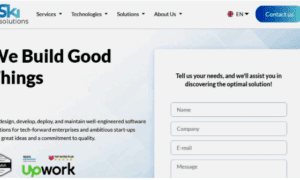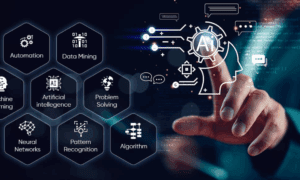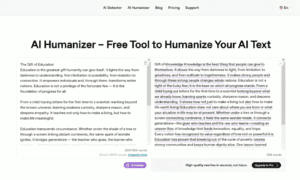Few professionals have navigated the complex journey from legacy systems to modern architectures as successfully as Sai Kiran Malikireddy, who represents a new generation of technical leaders who combine deep technical expertise with strategic business acumen. We recently were able to connect with him to dive into not only his past, but how he sees the space evolving in the future.
Malikireddy’s career trajectory reflects a pattern of continuous growth and adaptation to emerging technologies. As he describes it: “My career has been a journey of constant adaptation to emerging technologies and solving increasingly complex problems at scale.”
His professional path began at Bank of America, where he worked on migrating mainframe applications to Hadoop and Spark. This foundational experience taught him the fundamentals of distributed computing and data processing at scale.
The transition to Cisco proved pivotal in his career development. “The transition to Cisco was pivotal, as I moved from Software Engineer III to Senior Software Engineer in under two years,” Malikireddy explains. “There, I developed expertise in large-scale data processing for IoT systems, implementing solutions that could handle millions of connected devices while maintaining high availability.”

Sai Kiran Malikireddy
What separates Malikireddy from many technical specialists is his focus on business outcomes. “What’s been most fulfilling is seeing just how my work directly impacts the business,” he notes. “The cloud migration projects I’ve led have resulted in significant cost savings, while our privacy-focused architectures have strengthened customer trust and reduced regulatory risks.”
Throughout his career, Malikireddy has observed—and has helped to drive—a fundamental shift in how businesses manage data. “Enterprise data architecture has undergone a radical transformation—from batch-driven monoliths to real-time, AI-powered, cloud-native ecosystems,” he explains.
This evolution was evident across his career progression. “When I started at Bank of America, we were still heavily dependent on mainframe systems with overnight batch processing cycles that created substantial delays between data collection and insight generation,” he recalls.
The transition accelerated during his time at Cisco. “At Cisco, I witnessed the shift toward more distributed, real-time processing using technologies like Hadoop and Spark. But the most dramatic change has been the evolution toward fully real-time data platforms that operate in the cloud.”
Today’s enterprise data architectures bear little resemblance to their predecessors. “Modern data platforms orchestrate data flows using technologies like Apache NiFi for ingestion, Kafka for streaming, Flink for processing, and Spark for analytics,” Malikireddy describes. “They synchronize millions of customer interactions daily through various integrations, processing enormous volumes of events during peak periods.”
As privacy regulations have emerged globally, Malikireddy has positioned himself at the forefront of compliance-driven architecture. “Privacy and compliance have become central to my architectural decisions, especially as regulations like CCPA and GDPR have emerged,” he states. “These aren’t just legal frameworks—they’ve driven a shift toward privacy-first architectures where compliance is built into the core system design.”
One of his most significant contributions has been in developing innovative graph-based solutions. “One of my most significant contributions has been developing identity graph solutions, which manage complex customer relationships while ensuring CCPA and GDPR compliance,” Malikireddy explains. “These graph-based solutions prevent data breaches and reduce regulatory risks through automated data lineage tracking, consent management, and real-time data masking.”
The advantages of graph-based approaches extend beyond compliance to performance. “Graph-based solutions offer a unique advantage: they provide fine-grained access control and real-time data lineage tracking while maintaining high-speed performance at scale,” he notes.
He elaborates on the technical benefits: “Traditional relational databases rely on complex joins to enforce access control and privacy rules. As systems grow, enforcing privacy regulations becomes computationally expensive—leading to slower queries and bottlenecks.” By contrast, “The graph-based architectures I’ve worked with eliminate this complexity by storing relationships as first-class citizens.”
The business impact has been substantial. “This approach has been particularly valuable for fraud detection. By analyzing transaction patterns within the graph, we identify anomalies in real-time, enabling proactive fraud prevention and saving millions annually.”
Malikireddy has developed a structured approach to integrating machine learning into enterprise environments. “Integrating machine learning into enterprise systems requires a structured, engineering-first approach that balances accuracy, reliability, and real-time decision-making,” he explains.
His methodology begins with data infrastructure. “I’ve focused on building ML-ready data pipelines first. Real-time, high-quality data pipelines ensure continuous learning and accurate predictions,” he states. “I’ve implemented automated feature engineering with standardized feature stores to ensure models use consistent, reliable data across teams.”
Performance optimization has been another focus area. “For scalability and low-latency inference, I’ve optimized models through compression and quantization, reducing computational overhead while maintaining accuracy,” Malikireddy notes. “Deploying models via microservices ensures low-latency predictions, and using edge computing reduces cloud costs by running AI models closer to the data source.”
He emphasizes the importance of ongoing monitoring. “Continuous monitoring is essential since ML models degrade over time due to data drift. I’ve implemented robust ML observability with live model performance tracking to detect accuracy drops in production and automated retraining pipelines triggered by real-world feedback.”
Cloud optimization has also been a significant area of focus in Malikireddy’s work. “Cloud optimization has been a major focus in my work, where I’ve implemented several strategies to balance performance, resilience, and cost-efficiency,” he shares.
His approach is comprehensive, addressing multiple dimensions of cloud spending. “Rightsizing resources to match workloads has been our first priority. I’ve moved away from over-provisioning for peak loads and implemented auto-scaling and right-sizing to dynamically adjust based on demand,” he explains. “Using Spot instances for non-critical workloads and Reserved instances for predictable, long-term usage has cut compute costs significantly.”
Storage optimization presents different challenges. “For storage optimization, I’ve implemented tiering to move cold data to less expensive storage options and set up automated lifecycle policies to prevent unnecessary storage accumulation,” Malikireddy notes. “Deduplication and compression have further reduced costs by optimizing how data is stored across clusters.”
His strategy extends to networking costs as well. “Network and data transfer costs are often overlooked, so I’ve minimized inter-region transfers by deploying services and databases in the same region whenever possible. Leveraging CDNs to reduce outbound traffic and using private links for internal communication lowers egress costs.”
Beyond his technical contributions, Malikireddy has developed insights from mentoring emerging talent. “Through my mentoring experience, both in professional settings and during my volunteer work teaching math and statistics to students, I’ve found that technical professionals need a balance of deep expertise and adaptability,” he shares.
His guidance focuses on fundamental capabilities. “System design and scalability understanding are foundational—engineers must grasp distributed systems, cloud architecture, and performance optimization to build solutions that can grow with the business.”
He emphasizes several critical skill areas for modern engineers:
- “Data-driven decision-making has become increasingly important. The ability to work with big data, real-time analytics, and AI-driven insights is essential for optimizing products and operations.”
- “Security and privacy awareness are no longer optional skills. Engineers should understand Zero Trust security principles, identity and access management, encryption, and compliance requirements.”
- “Cloud and DevOps expertise—including Kubernetes, CI/CD pipelines, and Infrastructure as Code—ensures seamless deployments and operational efficiency.”
Malikireddy also advocates for continuous learning. “Perhaps most importantly, the ability to learn continuously and adapt to new technologies sets apart truly exceptional engineers. Technology evolves rapidly, and those who can self-learn, experiment, and embrace new paradigms will always be in demand.”


































